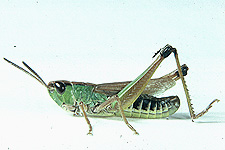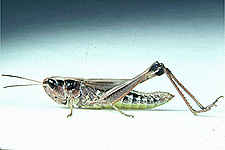Grasshoppers of Wyoming and the West
Entomology
Chorthippus curtipennis (Harris)
 |
 |
| Adult male | Adult female |
Common name - Marsh meadow locust (Blatchley, 1920).
Recent synonymy - Chorthippus longicornis (Latreille)
Geographic distribution - Europe and northern Asia; Alaska, Canada and the northern half of the United States but south to California, Arizona and New Mexico in western U.S. (Otte, 1981). In Colorado it primarily can be found from the mountain foothills to timberline (Hebard, 1929).
Habitat - damp meadows, swales and low, wet prairies (Blatchley, 1920; Hebard, 1929).
Food habits - graminivorous. Its preferred foods are Carex geyeri, needleandthread, Idaho fescue, Sandberg bluegrass, big bluestem and little bluestem (Banfill and Brusven, 1973; Gangwere, 1961; Mulkern et al., 1969).
Eggs - small pods contain five to eight light brown eggs. Average egg length, 4 mm; average diameter, 1 mm (Ball et al., 1942; Onsager and Mulkern, 1963).
Nymph - four instars (Uvarov, 1966).
Adult - small and slender to medium size. Color is variable. Face is slanted, and vertex
is rounded. Antennae are long and slender, yellow at the base, blending to black at
the tip. Dorsal posterior margin of pronotum is rounded. Female is short-winged. Male
wings are as long or longer than the abdomen. Color is usually light brown on top
with a black bar on each side extending back from the eyes and along the upper half
of the lateral lobes of the pronotum. Yellowish color below. Face and lower sides
of pronotum are sometimes grey or green. Wings are clear. Sides of abdomen have black
patches. Male, 12 mm; female, 20 mm (Blatchley, 1920; Brooks, 1958).
Males are active and noiseless. Females leap and tumble to escape (Blatchley, 1920).
Oviposition - eggs are deposited in or near clumps of grass and sometimes in decaying wood (Criddle, 1933a).
Seasonal history - eggs overwinter and hatch in June. Adults can be found in late July, August and September (Ball et al., 1942; Mulkern et al., 1964).
Abundance and importance - occurs at a wider range of altitudes than any other Colorado grasshopper but occurs only occasionally. Grain fields around marsh edges sometimes are injured by this grasshopper (Banfill and Brusven, 1973; Criddle, 1933a).
C. curtipennis fact sheet from the Field Guide to Common Western Grasshoppers
Next Species: Chortophaga viridifasciata
Previous Species: Chloealtis conspersa
Biology of Common Colorado Grasshoppers List
Biology of Common Colorado Grasshoppers
Grasshoppers of Colorado Contents
